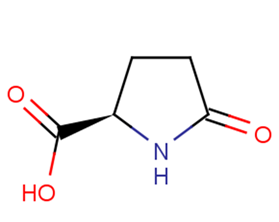
D-Pyroglutamic acid
CAS No. 4042-36-8
D-Pyroglutamic acid( (R)-(+)-2-Pyrrolidone-5-carboxylic acid )
Catalog No. M19602 CAS No. 4042-36-8
D-Pyroglutamic acid (PCA) is a cyclic derivative of glutamic acid physiologically present in mammalian tissues. It has been shown that PCA releases GABA from the cerebral cortex and displays anti-anxiety effects in a simple approach-avoidance conflict situation in the rat.
Purity : >98% (HPLC)
 COA
COA
 Datasheet
Datasheet
 HNMR
HNMR
 HPLC
HPLC
 MSDS
MSDS
 Handing Instructions
Handing Instructions
| Size | Price / USD | Stock | Quantity |
| 500MG | 58 | In Stock |


|
| 1G | 82 | In Stock |


|
Biological Information
-
Product NameD-Pyroglutamic acid
-
NoteResearch use only, not for human use.
-
Brief DescriptionD-Pyroglutamic acid (PCA) is a cyclic derivative of glutamic acid physiologically present in mammalian tissues. It has been shown that PCA releases GABA from the cerebral cortex and displays anti-anxiety effects in a simple approach-avoidance conflict situation in the rat.
-
DescriptionD-Pyroglutamic acid (PCA) is a cyclic derivative of glutamic acid physiologically present in mammalian tissues. It has been shown that PCA releases GABA from the cerebral cortex and displays anti-anxiety effects in a simple approach-avoidance conflict situation in the rat. In clinical pharmacology experiments PCA significantly shortens the plasma half-life of ethanol during acute intoxication.
-
In Vitro——
-
In Vivo——
-
Synonyms(R)-(+)-2-Pyrrolidone-5-carboxylic acid
-
PathwayOthers
-
TargetOther Targets
-
RecptorOthers
-
Research Area——
-
Indication——
Chemical Information
-
CAS Number4042-36-8
-
Formula Weight129.11
-
Molecular FormulaC5H7NO3
-
Purity>98% (HPLC)
-
SolubilityDMSO:10 mM
-
SMILESOC(=O)[C@H]1CCC(=O)N1
-
Chemical Name——
Shipping & Storage Information
-
Storage(-20℃)
-
ShippingWith Ice Pack
-
Stability≥ 2 years
Reference
1.Palekar AG et al. Accumulation of 50oxo-L-proline and 5-oxo-D-proline in the blood plasma in end stage renal disease. Biochem Med. 1975 Nov;14(3):339-45.
molnova catalog



related products
-
Adrenomedullin (AM) ...
Adrenomedullin (ADM) is a 52-aa hypotensive peptide. Adrenomedullin (ADM) has structural similarity with amylin.
-
TLR1
TLR1 is a cell-penetrating Toll/IL-1 receptor/resistance (TIR) domain/BB-Loop mimic and inhibits IL-1 receptor-mediated responses.
-
Trometamol
Trometamol is a proton acceptor used to treat acidemia.



 Cart
Cart
 sales@molnova.com
sales@molnova.com


